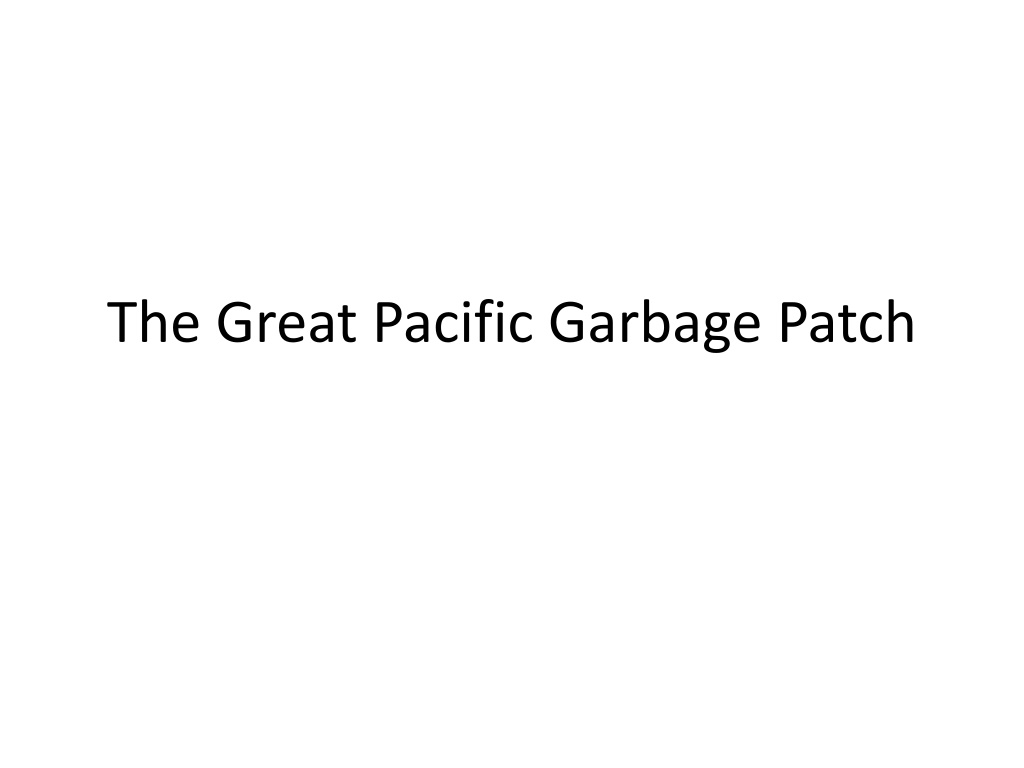The Great Pacific Garbage Patch - A Looming Environmental Crisis
The Great Pacific Garbage Patch is a massive collection of marine debris in the North Pacific Ocean, consisting mainly of non-biodegradable plastics that break down into harmful microplastics. This environmental issue, discovered by Captain Charles Moore, underscores the global problem of ocean pollution and the presence of garbage patches in other oceans as well. The extent of the debris and its impact on marine life highlight the urgent need for effective waste management and conservation efforts to combat this growing threat.
Download Presentation

Please find below an Image/Link to download the presentation.
The content on the website is provided AS IS for your information and personal use only. It may not be sold, licensed, or shared on other websites without obtaining consent from the author. Download presentation by click this link. If you encounter any issues during the download, it is possible that the publisher has removed the file from their server.
E N D
Presentation Transcript
The Great Pacific Garbage Patch is a collection of marine debris in the North Pacific Ocean. Also known as the Pacific trash vortex, the garbage patch is actually two distinct collections of debris bounded by the massive North Pacific Subtropical Gyre. http://nationalgeographic.org/encyclopedia/great-pacific-garbage-patch/
Worldwide Garbage Patches The Great Pacific Garbage Patch is not the only marine trash vortex it s just the biggest. The Atlantic and Indian Oceans both have trash vortexes. Even shipping routes in smaller bodies of water, such as the North Sea, are developing garbage patches.
The Great Pacific Garbage Patch sits near the surface of the ocean. Dense debris can sink centimeters or even several meters beneath the surface, making the vortex s area nearly impossible to measure. http://nationalgeographic.org/encyclopedia/great-pacific-garbage-patch/
Quotable Captain Capt. Charles Moore, discoverer of the Great Pacific Garbage Patch, in an article for Natural History magazine in 2003 "So on the way back to our home port in Long Beach, California, we decided to take a shortcut through the gyre, which few seafarers ever cross. Fishermen shun it because its waters lack the nutrients to support an abundant catch. Sailors dodge it because it lacks the wind to propel their sailboats. "Yet as I gazed from the deck at the surface of what ought to have been a pristine ocean, I was confronted, as far as the eye could see, with the sight of plastic. "It seemed unbelievable, but I never found a clear spot. In the week it took to cross the subtropical high, no matter what time of day I looked, plastic debris was floating everywhere: bottles, bottle caps, wrappers, fragments. Months later, after I discussed what I had seen with the oceanographer Curtis Ebbesmeyer, perhaps the world's leading expert on flotsam, he began referring to the area as the 'eastern garbage patch.'"
Most debris in the Great Pacific Garbage Patch is plastic. Plastic is not biodegradable, meaning it does not disintegrate it simply breaks into tinier and tinier pieces, known as microplastics. Microplastics of the Great Pacific Garbage Patch can simply make the water look like a cloudy soup. http://nationalgeographic.org/encyclopedia/great-pacific-garbage-patch/
Mixed in with microplastics are larger pieces of plastic. Most plastics are refuse from land activities in North American and Asia. Some plastics are accidentally dumped from oceangoing vessels. All the plastics on this page were culled from the Great Pacific Garbage Patch. http://nationalgeographic.org/encyclopedia/great-pacific-garbage-patch/
Strange Cargo When ships are caught in storms, they often lose cargo to the oceans. The following are just a few of the strange items that have washed up on shores: In 1990, five shipping containers of Nike sneakers and work boots were lost to the Pacific in a storm. People in Washington and Oregon snatched up the shoes on shore, holding swap meets to find matched pairs to wear or sell. In 1992, rubber duckies floated in the Pacific when a ship lost tens of thousands of bathtub toys. The ducks were accompanied by turtles, beavers, and frogs. In 1994, a ship lost 34,000 pieces of hockey gear, including gloves, chest protectors, and shin guards. http://nationalgeographic.org/encyclopedia/great-pacific-garbage-patch/
Marine debris can prevent algae and plankton, the photosynthetic producers in the marine food web, from receiving enough sunlight to create nutrients. When these tiny organisms are threatened, the entire food web is put at risk first-order consumers that eat the plankton, such as jellies; second-order consumers that eat the jellies, such as turtles; and apex predators such as sharks. http://nationalgeographic.org/encyclopedia/great-pacific-garbage-patch/
The marine debris of the Great Pacific Garbage Patch can devastate marine life in the North Pacific Subtropical Gyre. The stomach contents of this unfortunate albatross include plastic marine debris fed to the chick by its parents. http://nationalgeographic.org/encyclopedia/great-pacific-garbage-patch/
Turtles, too, are put in danger by marine debris. Turtles can easily be entangled in discarded fishing nets or mistake the gelatinous texture of plastic for a jelly, their favorite food. http://nationalgeographic.org/encyclopedia/great-pacific-garbage-patch/
Perhaps one of the starkest impacts on marine life is the phenomenon of "ghost fishing." Most large debris in the Great Pacific Garbage Patch is made up of inexpensive fishing nets. Ghost fishing happens when these discarded nets continue to "catch" marine life suffocating marine mammals such as this endangered Hawaiian monk seal. http://nationalgeographic.org/encyclopedia/great-pacific-garbage-patch/
























